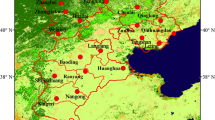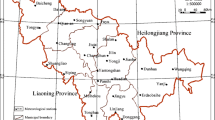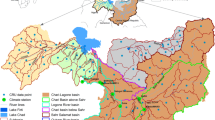Abstract
Qinghai-Tibet Plateau has a special geographical location and large lake groups making it an important research subject of global climate change and regional response. Taking its 149 typical lakes as the research subject, using the relevant features of lake area data from 1985 to 2020, the variation of the lake area, the chronological division of climate change, and the impact of climate features on the lake area growth rate are analyzed. The main methods and results include the following: (1) By using the time series clustering algorithm to mine the shape similarity of lake area change, three patterns of area change, C1, C2 and C3 modes, which show a slow growth trend, a strong fluctuation, and a significant growth trend, respectively, are summarized. (2) When the optimal segmentation point index of the binary sequence is proposed and combined with the clustering results of the lake regional climate to find the year of the optimal segmentation point for all lakes, the regional climate segmentation points of lakes are concentrated from 1995 to 2005. (3) When researching the lakes in C3 mode, using the XGBoost model as the regression model to extract the feature importance affecting lake growth rate, the effect of precipitation on lake area is the highest, followed by surface temperature. When a double machine learning model is established to conduct causal analysis to obtain an unbiased estimation of the lake area growth rate influenced climate features, the effect of precipitation is the highest, followed by evaporation. The methods used and the results show a new perspective in understanding climate change and lake response.







Similar content being viewed by others
Availability of Data and Materials
The original data used in this study are openly available in GEE https://earthengine.google.com/. The organized data used for modeling can be shared after rational requests.
References
An, Z. S. (2000). The history and variability of the East Asian paleomonsoon climate. Quaternary Science Reviews, 19(1–5), 171–187.
Krause, P., Biskop, S., Helmschrot, J., et al. (2010). Hydrological system analysis and modelling of the Nam Co basin in Tibet. Advances in Geosciences, 27, 29–36.
Immerzeel, W. W., Van Beek, L. P. H., & Bierkens, M. F. P. (2010). Climate change will affect the Asian water towers. Science, 328(5984), 1382–1385.
Tian, K., Huang, Y., Xie, J., et al. (2018). Half of China’s lakes are on the Qinghai-Tibet Plateau. Forests and People, 12, 16. (in Chinese).
Zhu, L., & Yao, T. (2006). Response of the Qinghai-Tibet Plateau to global changes and its adaptation measures. Advances in Earth Sciences, 21(5), 459–464. (in Chinese).
Liu, J., Wang, S., Yu, S., et al. (2009). Climate warming and growth of high-elevation inland lakes on the Tibetan Plateau. Global and Planetary Change, 67(3–4), 209–217.
Yang, K., Wu, H., Qin, J., et al. (2014). Recent climate changes over the Tibetan Plateau and their impacts on energy and water cycle: A review. Global and Planetary Change, 112, 79–91.
Wei, W., Xiao, P., Feng, X., et al. (2014). Monitoring lake changes of Qinghai-Tibetan Plateau over the past 30 years using satellite remote sensing data. Chinese Science Bulletin, 8, 701–714.
Mironovy, D. (2008). Parameterization of lakes in numerical weather prediction: Description of a lake model. 2008, COSMO Technical Report.
Subin, ZM., Riley, WJ., & Mironov, D. (2012). An improved lake model for climate simulations: Model structure, evaluation, and sensitivity analyses in CESM1. Journal of Advances in Modeling Earth Systems, 4(1), M02001.
Gaillard, R., Perroud, M., Goyette, S., et al. (2022). Multi-column modelling of lake Geneva for climate applications. Scientific reports, 12(1), 1–12.
Song, X., Wen, L., Li, M., et al. (2020). Comparative study on the applicability of different lake models to typical lakes on the Qinghai-Tibet Plateau. Highland Meteorology, 39(2), 13. (in Chinese).
Lei, Y., Yang, K., Wang, B., et al. (2014). Response of inland lake dynamics over the Tibetan Plateau to climate. Climatic Change, 125, 281–290.
Ma, Y., Ma, W., Zhong, L., et al. (2017). Monitoring and modeling the Tibetan Plateau’s climate system and its impact on East Asia. Scientific Reports, 7, 44574.
d'Orgeville, M., Peltier, W. R., Erler, A. R., & Gula, J. (2014). Climate change impacts on Great Lakes Basin precipitation extremes. Journal of Geophysical Research, D. Atmospheres: JGR, 119(18): 10799–10812.
Yang, M., Zhao, W., & Zhan, Q. (2020). Analysis of the spatial and temporal variations of land surface temperature over the Tibetan Plateau from 2000 to 2018. IGARSS 2020 - 2020 IEEE International Geoscience and Remote Sensing Symposium. IEEE.
Li, Y., Wang, T., & Zhao, L. (2019). Characteristics of lake area changes and their response to climate change in the Qinghai-Tibet Plateau from 1970 to 2015. Quaternary International, 514, 17–28.
Chen, F. H., Chen, J. H., Holmes, J., et al. (2015). Moisture changes over the last millennium in arid central Asia: A review, synthesis and comparison with monsoon region. Quaternary Science Reviews, 122, 151–166.
Liao, J., Shen, G., & Li, Y. (2013). Lake variations in response to climate change in the Tibetan Plateau in the past 40 years. International Journal of Digital Earth, 6, 534–549.
Kuang, X., & Jiao, J. (2016). Review on climate change on the Tibetan Plateau during the last half century. Journal of Geophysical Research, D. Atmospheres: JGR, 121(8):3979–4007.
Ni, Z., Lv, X., & Huang, G. (2021). Impact of meteorological factors on Thermokarst Lake changes in the Beilu River basin, Qinghai-Tibet Plateau, China (2000–2016). Water, 13(11), 1605.
Su, D., Hu, X., Wen, L., et al. (2019). Numerical study on the response of the largest lake in China to climate change. Hydrology and Earth System Sciences, 23(4), 2093–2109.
Yang, K., Wang, J., Lei, Y., et al. (2016). Quantifying evaporation and its decadal change for Lake Nam Co, central Tibetan Plateau. Journal of Geophysical Research: Atmospheres, 121(13), 7578–7591.
Zhang, G., Yao, T., Xie, H., et al. (2014). Lakes’ state and abundance across the Tibetan Plateau. Chinese Science Bulletin, 59(24), 3010–3021.
Samuelsson, P., Kourzeneva, E., & Mironov, D. (2010). The impact of lakes on the European climate as simulated by a regional climate model. Boreal Environment Research, 15(2), 113–129.
Zhang, G., Yao, T., Piao, S., et al. (2017). Extensive and drastically different alpine lake changes on Asia’s high plateaus during the past four decades. Geophysical Research Letters, 44(1), 252–260.
Li, P., Dong, L., Xiao, H., et al. (2015). A cloud image detection method based on SVM vector machine. Neurocomputing, 169, 34–42.
Mao, K., Yang, J., Han, X., et al. (2018). Research on surface temperature inversion algorithm based on deep dynamic learning neural network and radiative transfer model. China Agricultural Information, 30(05), 47–57. (in Chinese).
Cui, B., Chen, X., & Lu, Y. (2020). Semantic segmentation of remote sensing images using transfer learning and deep convolutional neural network with dense connection. IEEE Access, 99, 1–1.
Shi, X., Chen, Z., Wang, H., et al. (2015). Convolutional LSTM network: A machine learning approach for precipitation nowcasting. Advances in neural information processing systems, 28.
Xiao, X., Kuang, Q., Xiang, S., et al. (2019). Precipitation forecasting via multi-scale deconstructed ConvLSTM. https://doi.org/10.48550/arXiv.1912.09425
Wu, J., Li, W., & Kong, D. (2018). Application of a novel joint model in multi-site simultaneous precipitation forecasting. Water Conservation and Irrigation, 11, 111–114. (in Chinese).
Deweber, J. T., & Wagner, T. (2014). A regional neural network ensemble for predicting mean daily river water temperature. Journal of Hydrology, 5(17), 187–200.
Reghunath, R., Murthy, T. R. S., & Raghavan, B. R. (2002). The utility of multivariate statistical techniques in hydrogeochemical studies: An example from Karnataka. India. Water Research, 36(10), 2437–2442.
Arthur, D. and Vassilvitskii, S.(2007). K-Means++: The advantages of careful seeding. In Proceedings of the eighteenth annual ACM-SIAM symposium on Discrete algorithms, New Orleans, SIAM, 1027–1035.
Paparrizos, J., & Gravano, L. (2016). k-Shape: Efficient and accurate clustering of time series. ACM SIGMOD Record, 45(1), 69–76.
Robinson, P. M. (1988). Root- N-consistent semiparametric regression. Econometrica, 56(4), 931–954.
Kang, S., Xu, Y., You, Q., et al. (2010). Review of climate and cryospheric change in the Tibetan Plateau. Environmental Research Letters, 5(1), 15101–15101.
Zhang, G. (2018). Changes in lakes on the Tibetan Plateau observed from satellite data and their responses to climate variations. Progress In Geography, 37(2), 214–223. (in Chinese).
Novitasari, D. C. R., Rohayani, H., et al. (2020). Weather parameters forecasting as variables for rainfall prediction using adaptive neuro fuzzy inference system (ANFIS) and support vector regression (SVR). Journal of Physics Conference Series, 1501(1).
Zhao, J., Zhang, C., Min, L., Guo, Z., & Li, N. (2022). Retrieval of farmland surface soil moisture based on feature optimization and machine learning. Remote Sensing, 14(20).
Elena, B., Doina, S., & Daniela, V. (2015). The impact of anthropogenic activities on components of the natural environment of the Titu Plain. GEOREVIEW: Scientific Annals of Stefancel Mare University of Suceava. Geography Series, 24(1).
Li, Q., Zhang, C., Shen, Y., Jia, W., & Li, J. (2016). Quantitative assessment of the relative roles of climate change and human activities in desertification processes on the Qinghai-Tibet Plateau based on net primary productivity. Catena, 147.
Funding
This study was supported by the National Key Research and Development Program of China (No. 2019YFA0607104), and the National Natural Sciences Foundation of China (No. 42130113). The numerical calculations in this paper are supported by the Supercomputing Center of Lanzhou University.
Author information
Authors and Affiliations
Contributions
All authors contributed to the study conception and design. Hao He: Conceptualization, Methodology, Software, Data Curation, Visualization, Writing-Original Draft. Weide Li: Conceptualization, Supervision, Resources, Writing-Reviewing and Editing, Funding acquisition. Min Qian: Writing-Reviewing and Editing. Shujuan Hu: Conceptualization, Writing-Reviewing and Editing, Resources, Funding acquisition.
Corresponding author
Ethics declarations
Competing Interests
The authors declare that they have no known competing financial interests or personal relationships that could have appeared to influence the work reported in this paper.
Additional information
Publisher's Note
Springer Nature remains neutral with regard to jurisdictional claims in published maps and institutional affiliations.
Appendix
Appendix
Rights and permissions
Springer Nature or its licensor (e.g. a society or other partner) holds exclusive rights to this article under a publishing agreement with the author(s) or other rightsholder(s); author self-archiving of the accepted manuscript version of this article is solely governed by the terms of such publishing agreement and applicable law.
About this article
Cite this article
He, H., Li, W., Qian, M. et al. Time Series Clustering and Influencing Factors Analysis on Qinghai-Tibet Plateau Lake Area Change. Environ Model Assess (2023). https://doi.org/10.1007/s10666-023-09913-1
Received:
Accepted:
Published:
DOI: https://doi.org/10.1007/s10666-023-09913-1




